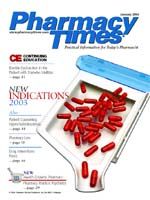Publication
Article
Pharmacy Times
Optimizing Computer Systems for Medication Safety
Computers, either for stand-alone pharmacy systems or for electronic prescribing, are common, essential professional tools that can increase staff efficiency and support effective drug utilization review and therapeutic drug monitoring. At the same time, pharmacists, physicians, and nurses must not place sole reliance on these tools as a means to protect patients from drug-induced harm.
Many of today's computer order-entry systems provide vendor-defined and user-defined alerts that remind or warn staff members about potential drug-related problems during order entry. The Institute for Safe Medication Practices (ISMP) often recommends these alerts as a way to inform the staff about potential errors. Clinicians and managers, however, have expressed concern that the sheer number of warnings that appear on the screen during order entry can be overwhelming and can slow the process. In many cases, clinically insignificant warnings are as likely to appear as are those that are vital. As a result, staff members may inadvertently bypass even critical warnings, especially when the workload is high.
Bypassing warnings is easy to do with many systems. In an informal survey of computer systems, the ISMP found that, all too often, simply striking the "Enter" key bypasses an alert - even a warning that could prevent serious or fatal errors. If the system forces a response to the warning, practitioners who feel pressured to rush through order entry may select the first reason listed on the screen instead of appropriately addressing the issue. Another issue is that, when pharmacists or nurses are properly alerted to a potential allergic reaction or harmful drug interaction, they may erroneously assume that the prescriber is already aware of the problem and fail to alert the prescriber directly.
When practitioners become accustomed to receiving unimportant or clinically irrelevant warnings, they often ignore these "false alarms," or turn them off - at least mentally. Here are some strategies that can be used to optimize the effectiveness of alerts and minimize the possibility of overlooking the more significant warnings:
- Use a tiered system for interactive warnings that allows staff members to view and consider possible warnings but easily bypass less serious issues, if appropriate. Require a text entry to describe the response to more significant alerts.
- Assign pharmacists who enter orders the task of noting any warnings that they feel are not clinically significant. The severity level of certain alerts may need to be changed in order not to "overload" the pharmacist. Wholesale changing of severity levels according to vendor specifications should be done with caution. Some organizations have adjusted their systems so that only high-severitylevel drug-interaction warnings from their vendor appear. ISMP has been told, however, that the drug-interaction leveling system used by some drug-information vendors is based on the volume of clinically documented cases, rather than on an evaluation of the potential for patient harm. Therefore, check with your vendor to fully understand how the vendor assigns severity levels before making any changes.
- Make significant alerts as visible as possible. Some systems may allow large screen fonts in a contrasting color, flashing messages, sounds, or other means of distinguishing the alert.
- Maximize a system's capabilities whenever possible by incorporating serious error-prone situations that have been reported in the ISMP Medication Safety Alert! as well as other publications.
- Review noninteractive pop-up messages on an ongoing basis?such as the alerts we suggest for avoiding drug name mix-ups. Delete any that are no longer applicable.
- Apply auxiliary labels to drug packages and storage shelves to warn about unclear or confusing labeling and packaging, instead of using certain messages in the computer system.
- Consider printing warnings on drug labels or medication storage areas instead of building alerts into the order-entry process. For example, print "Topical or External Use Only" warnings on drug labels for all drugs that can be administered safely only by this route.
Many systems are capable of providing reports about all warnings that have been overridden. Assign a pharmacist to regularly review the report and periodically identify those warnings that are continually overridden. Share report results with staff members before making changes to the computer system. Consider focusing on 1 or 2 common but critically important warnings to monitor the effectiveness of the computer's alert system and the response to the alert.
The ISMP is interested in learning about any other strategies that have been used at your practice site to optimize the use of your computer warning system. Please contact ISMP by email ([email protected]) or by telephone (800-324-5723; ask for Kate Kelly) with your suggestions so that we can share them with others.

Newsletter
Stay informed on drug updates, treatment guidelines, and pharmacy practice trends—subscribe to Pharmacy Times for weekly clinical insights.






